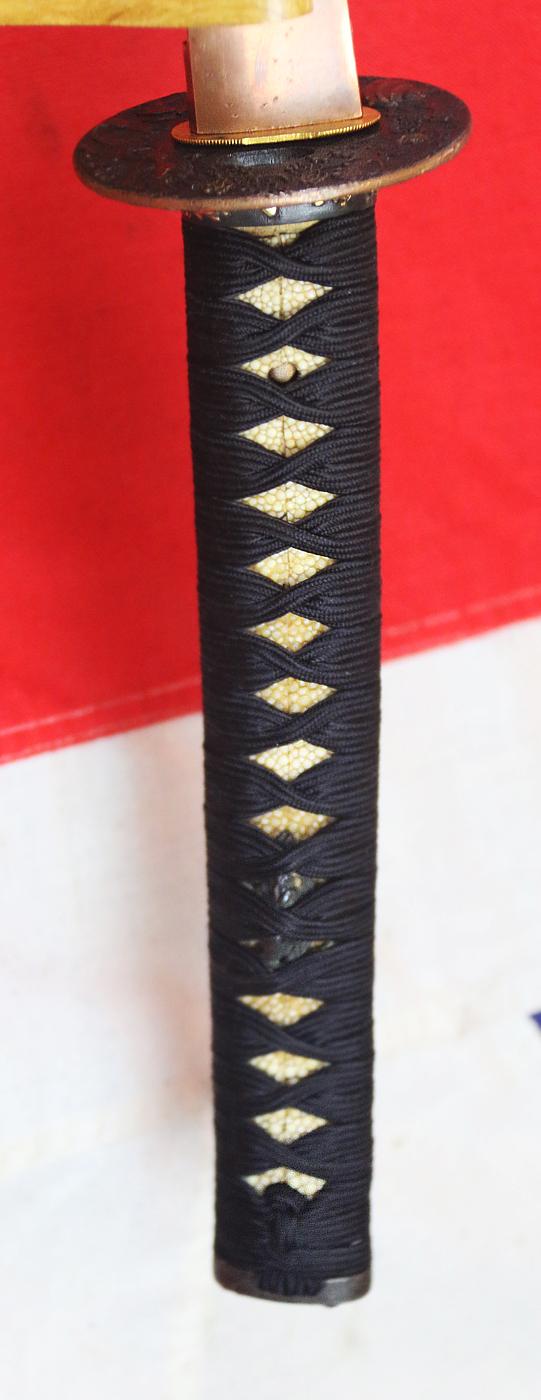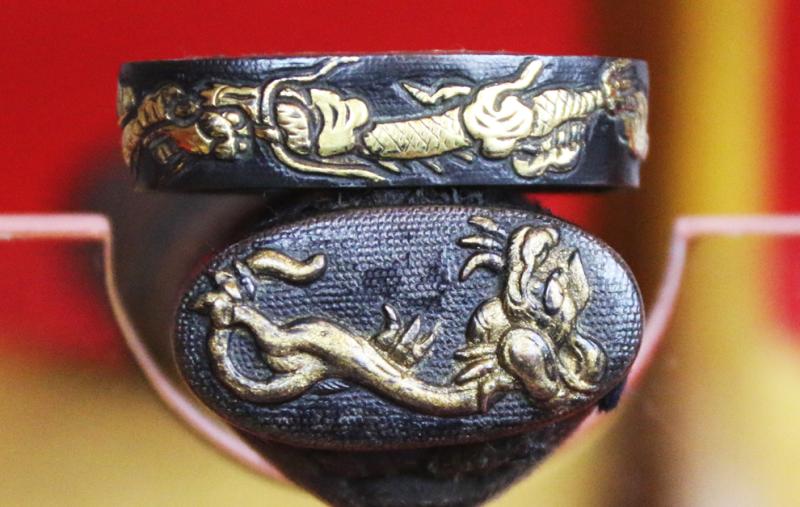A Sengoku Era Samurai Battle Katana, Koto Period, With An Amazing Blade, & All Original Edo Fittings Circa 1500.
With all original Edo period mounts, the fuchi is of pure gold decoration on dragon over shakudo on a nanako ground see below for the details on nanako-ji, the fuchi of gilt dragon on shakudo on a nanako ground. A very attractive patinated copper tsuba with gold highlights, on the takebori decoration of two samurai kabuto helmets and a pair of abumi samurai stirrups with a background of prunus blossom on a nanako ground. The blade has an amazing hamon, and grain {somewhat akin to woodgrain} in the hada, and the polish is simply beautiful. The Sengoku period was initiated by the Ōnin War in 1467 which collapsed the feudal system of Japan under the Ashikaga Shogunate. The Sengoku period was named by Japanese historians after the similar but otherwise unrelated Warring States period of China. The era is beautifully depicted in Akira Kurowsawa’s films called Jidaigeki. The Sengoku Period (1467-1568 CE) was a lawless century-long era characterized by rising political instability, turmoil, and warlordism in Japan. During this period, field armies and soldiers rapidly rose in number, reaching tens of thousands of warriors. Many castles in Japan were built during the Sengoku Period as regional leaders and aristocrats alike competed for power and strong regional influence to win the favours of the higher-class Japanese at the time. Kurosawa’s film depiction of Macbeth, Throne of Blood, is set in this era of Japan’s feudal period. Original title 蜘蛛巣城, Kumonosu-jō, lit. 'The Castle of Spider's Web'
This then led to the creation of a more complex system within the military, the armoured infantry known as the ashigaru. Initiated by the collapse of the country’s feudal system during the 1467 Onin War, rival warlords or daimyō, continued to struggle to gain control of Japan until its reunification under Japan’s three “Great Unifiers” –– Nagoya Nobunaga, Hideyoshi, and Ieyasu Tokugawa –– thus, bringing the war-stricken era to an end in the siege of Osaka.
The samurai were roughly the equivalent of feudal knights. Employed by the shogun or daimyo, they were members of hereditary warrior class that followed a strict "code" that defined their clothes, armour and behaviour on the battlefield. But unlike most medieval knights, samurai warriors could read and they were well versed in Japanese art, literature and poetry.
Samurai endured for almost 700 years, from 1185 to 1867. Samurai families were considered the elite. They made up only about six percent of the population and included daimyo and the loyal soldiers who fought under them. Samurai means one who serves."
Samurai were expected to be both fierce warriors and lovers of art, a dichotomy summed up by the Japanese concepts of bu to stop the spear expanding into bushido (the way of life of the warrior) and bun (the artistic, intellectual and spiritual side of the samurai). Originally conceived as away of dignifying raw military power, the two concepts were synthesised in feudal Japan and later became a key feature of Japanese culture and morality.The quintessential samurai was Miyamoto Musashi, a legendary early Edo-period swordsman who reportedly killed 60 men before his 30th birthday and was also a painting master. Members of a hierarchal class or caste, samurai were the sons of samurai and they were taught from an early age to unquestionably obey their mother, father and daimyo. When they grew older they may be trained by Zen Buddhist masters in meditation and the Zen concepts of impermanence and harmony with nature. The were also taught about painting, calligraphy, nature poetry, mythological literature, flower arranging, and the tea ceremony.
it has been said that part of their military training, samurai were taught to sleep with their right arm underneath them so if they were attacked in the middle of the night and their the left arm was cut they could still fight with their right arm. Samurai that tossed and turned at night might be cured of the habit by having two knives placed on either side of their pillow, but that may be part myth.
Samurai have been describes as "the most strictly trained human instruments of war to have existed." They were expected to be proficient in the martial arts of aikido and kendo as well as swordsmanship and archery---the traditional methods of samurai warfare---which were viewed not so much as skills but as art forms that flowed from natural forces that harmonized with nature.
Some samurai, it has been claimed, didn't become a full-fledged samurai until he wandered around the countryside as begging pilgrim for a couple of years to learn humility. When this was completed they achieved samurai status and receives a salary from his daimyo paid from taxes (usually rice) raised from the local populace.
Nanako Ji: "fish roe ground" A surface decoration produced by forming very small raised bosses by a sharply struck punch or burin called 'nanako tagane'. Shakudo is the metal most often used, but copper and gold are quite often employed. The harder metals, shibuichi, silver and iron are rarely decorated in this way. The size of the dots vary from 0.04" to 0.008" (25 to 125 and inch) and the regularity of the work is marvelous as the dots must be spaced entirely by touch. The dots are usually arranged in straight lines or in lines parallel to the edge of the piece being decorated, but sometimes in more elaborate patterns. Used on guards since the Momoyama period although the technique existed since much earlier periods. Usually done by specialist 'nanako-shi', but sometimes done by the maker of the guard himself. The articles of sword ornamentation made by the Goto artists were practically all on shakudo grounds with nanako finish; after the emergence of the machibori artisans in the mid-Edo period and the popularity of the newly inspired kozuka, shakudo grounds with nanako finish "became the rage". Nanako finish is probably an evolution and refinement of a very old style finish (which it vaguely resembles); "millet finish", 'awa ishime', which is found on some old armorer tsuba. However, awa ishime consisted of small, round dimples punched into the surface of the ground; on the other hand, nanako is formed by striking the ground with a cup-shaped punch to raise, and project upward from the surface, small semi-hemispheric nipples. Since we find nanako finish on old yamagane grounds, it was in use as early as the Kamakura period. It is note-worthy that a nanako finish on a shakudo ground has been used since the time of the first Goto 1440 - 151 in the mitokoromono, "set of three", for use on formal or ceremonial occasions. Later, shakudo nanako became the regular finish for use by the metal artisans. (deleted repeated sentences) In applying nanako, meticulous and scrupulous care must be used in positioning and striking the "cupping tool" in order to achieve fine, regular, carefully and closely spaced, identical results, row after row. Careless, imprecise and even coarse workmanship can be detected in the nanako of some older works and on "ready made" products, but work of later years, executed with infinite and scrupulous care, are beautiful beyond belief. However, even the finest of execution of nanako finish applied to brass (shinchu) or shibuichi fails to carry the distinct air of refinement and elegance of similar work on shakudo. The very elegance of nanako workmanship reflects not only the extraordinary skills of the Japanese in the execution of minute, detailed work, but also their tremendous patience and artistic inspiration. It is said that blindness of nanako workers at thirty years of age was usual because of the microscopic and meticulous work so carefully and patiently executed. On many old tsuba, pre-dating the period of the Goto, one encounters nanako laid in horizontal or vertical rows; on subsequent work nanako was applied along curved lines conforming to the shape of the tsuba.
In the current photos the saya lacquer appears slightly bruised, these slight marks have been removed and now the urushi lacquer looks perfect. Blade length 26.75 inches, overall in saya 37 inches
Akira Kurowsawa & Jidaigeki
Did you know? the most valuable sword in the world today is a samurai sword, it belongs to an investment fund and has appeared illustrated in the Forbes 400 magazine. It is valued by them at $100 million, it is a tachi from the late Koto period 16th century and unsigned. That sword's blade is now grey and now has no original polish remaining.
Every single item from The Lanes Armoury is accompanied by our unique Certificate of Authenticity. Part of our continued dedication to maintain the standards forged by us over the past 100 years of our family’s trading, as Britain’s oldest established, and favourite, armoury and gallery
Code: 24387
6450.00 GBP










